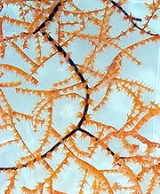
Black coral
Encyclopedia
Black corals are a group of deep water, tree-like coral
s related to sea anemone
s. They are also found in rare dark shallow water areas such as New Zealand
's Milford Sound
where they can be viewed from an underwater observatory. They normally occur in the tropics
. There are about 230 known species of Antipatharians in 42 genera.
Though black coral's living tissue is brilliantly colored, it takes its name from the distinctive black or dark brown color of its skeleton. Also unique to black coral are the tiny spines that cover the surface of the skeleton, the origin of the nickname little thorn coral. In the Hawaiian language
, black coral is called ‘ēkaha kū moana and is the official state gem of Hawaii
. Black coral is listed in Appendix II of the Convention on International Trade in Endangered Species (CITES).
Family Aphanipathidae
Family Cladopathidae
Family Leiopathidae
Family Myriopathidae
Family Schizopathidae
Family Stylopathidae
Coral
Corals are marine animals in class Anthozoa of phylum Cnidaria typically living in compact colonies of many identical individual "polyps". The group includes the important reef builders that inhabit tropical oceans and secrete calcium carbonate to form a hard skeleton.A coral "head" is a colony of...
s related to sea anemone
Sea anemone
Sea anemones are a group of water-dwelling, predatory animals of the order Actiniaria; they are named after the anemone, a terrestrial flower. Sea anemones are classified in the phylum Cnidaria, class Anthozoa, subclass Zoantharia. Anthozoa often have large polyps that allow for digestion of larger...
s. They are also found in rare dark shallow water areas such as New Zealand
New Zealand
New Zealand is an island country in the south-western Pacific Ocean comprising two main landmasses and numerous smaller islands. The country is situated some east of Australia across the Tasman Sea, and roughly south of the Pacific island nations of New Caledonia, Fiji, and Tonga...
's Milford Sound
Milford Sound
Milford Sound is a fjord in the south west of New Zealand's South Island, within Fiordland National Park, Piopiotahi Marine Reserve, and the Te Wahipounamu World Heritage site...
where they can be viewed from an underwater observatory. They normally occur in the tropics
Tropics
The tropics is a region of the Earth surrounding the Equator. It is limited in latitude by the Tropic of Cancer in the northern hemisphere at approximately N and the Tropic of Capricorn in the southern hemisphere at S; these latitudes correspond to the axial tilt of the Earth...
. There are about 230 known species of Antipatharians in 42 genera.
Though black coral's living tissue is brilliantly colored, it takes its name from the distinctive black or dark brown color of its skeleton. Also unique to black coral are the tiny spines that cover the surface of the skeleton, the origin of the nickname little thorn coral. In the Hawaiian language
Hawaiian language
The Hawaiian language is a Polynesian language that takes its name from Hawaii, the largest island in the tropical North Pacific archipelago where it developed. Hawaiian, along with English, is an official language of the state of Hawaii...
, black coral is called ‘ēkaha kū moana and is the official state gem of Hawaii
Hawaii
Hawaii is the newest of the 50 U.S. states , and is the only U.S. state made up entirely of islands. It is the northernmost island group in Polynesia, occupying most of an archipelago in the central Pacific Ocean, southwest of the continental United States, southeast of Japan, and northeast of...
. Black coral is listed in Appendix II of the Convention on International Trade in Endangered Species (CITES).
Families
Family Antipathidae- Allopathes
- Antipathes Pallas, 1766
- Aphanipathes Brook, 1889
- Arachnopathes
- Cirrhipathes de Blainville, 1830
- Hillopathes
- Pteropathes
- Schizopathes
- Stichopathes
- Tylopathes
Family Aphanipathidae
- Acanthopathes
- Asteriopathes
- Distichopathes
- Elatopathes
- Phanopathes
- Pteridopathes
- Rhipidopathes
- Tetrapathes
Family Cladopathidae
- Chrysopathes Opresko, 2003
- Cladopathes Brook, 1889
- Heliopathes Opresko, 2003
- Hexapathes Kinoshita, 1910
- Sibopathes van Pesch, 1914
- Trissopathes Opresko, 2003
Family Leiopathidae
- Leiopathes Haime, 1849
Family Myriopathidae
- Antipathella
- Apanipathes
- Aphanipates
- Cupressopathes
- Hydradendrium
- Myriopathes
- Plumapathes
- Tanacetipathes
Family Schizopathidae
- Abyssopathes
- Bathypathes Brook, 1889
- Dendrobathypathes
- Dendropathes
- Lillipathes
- Parantipathes Brook, 1889
- Saropathes
- Stauropathes
- Taxipathes
- Umbellapathes
Family Stylopathidae
- Stylopathes
- Triadopathes
Lifespan
In March 2009, scientists released the results of their research on deep-sea (depths of ~300 to 3,000 m) corals throughout the world. They discovered a subdivision of Black Coral, A. Leiopathes sp. specimens, to be among the oldest continuously living organisms on the planet; around 4,265 years old. They show that the "radial growth rates are as low as 4 to 35 micrometers per year and that individual colony longevities are on the order of thousands of years".External links
- http://www.marinespecies.org/aphia.php?p=taxdetails&id=22549
- Antipathidae entry at Animal Diversity Web

